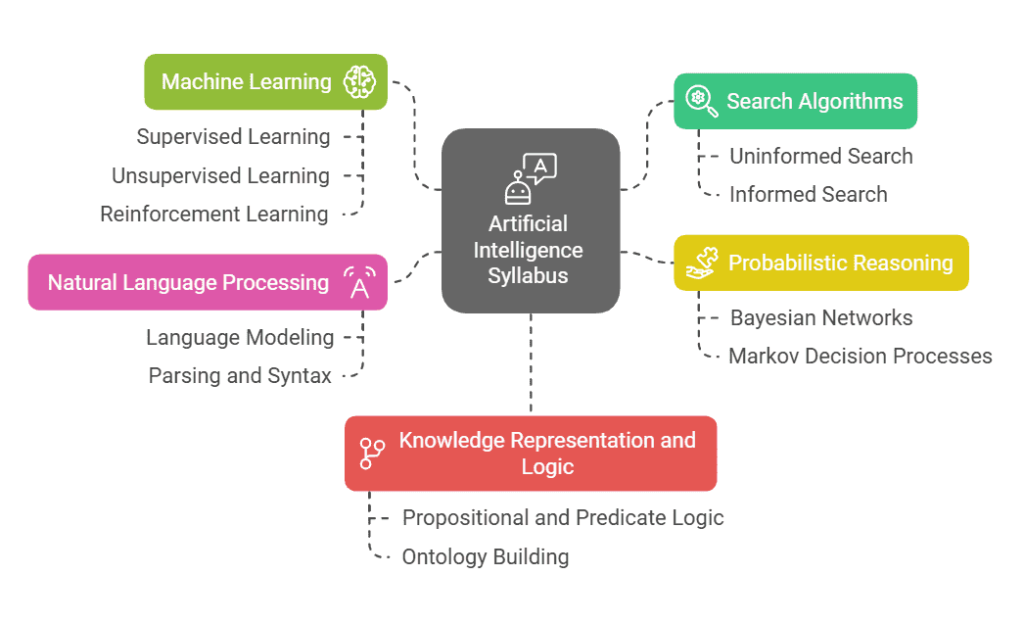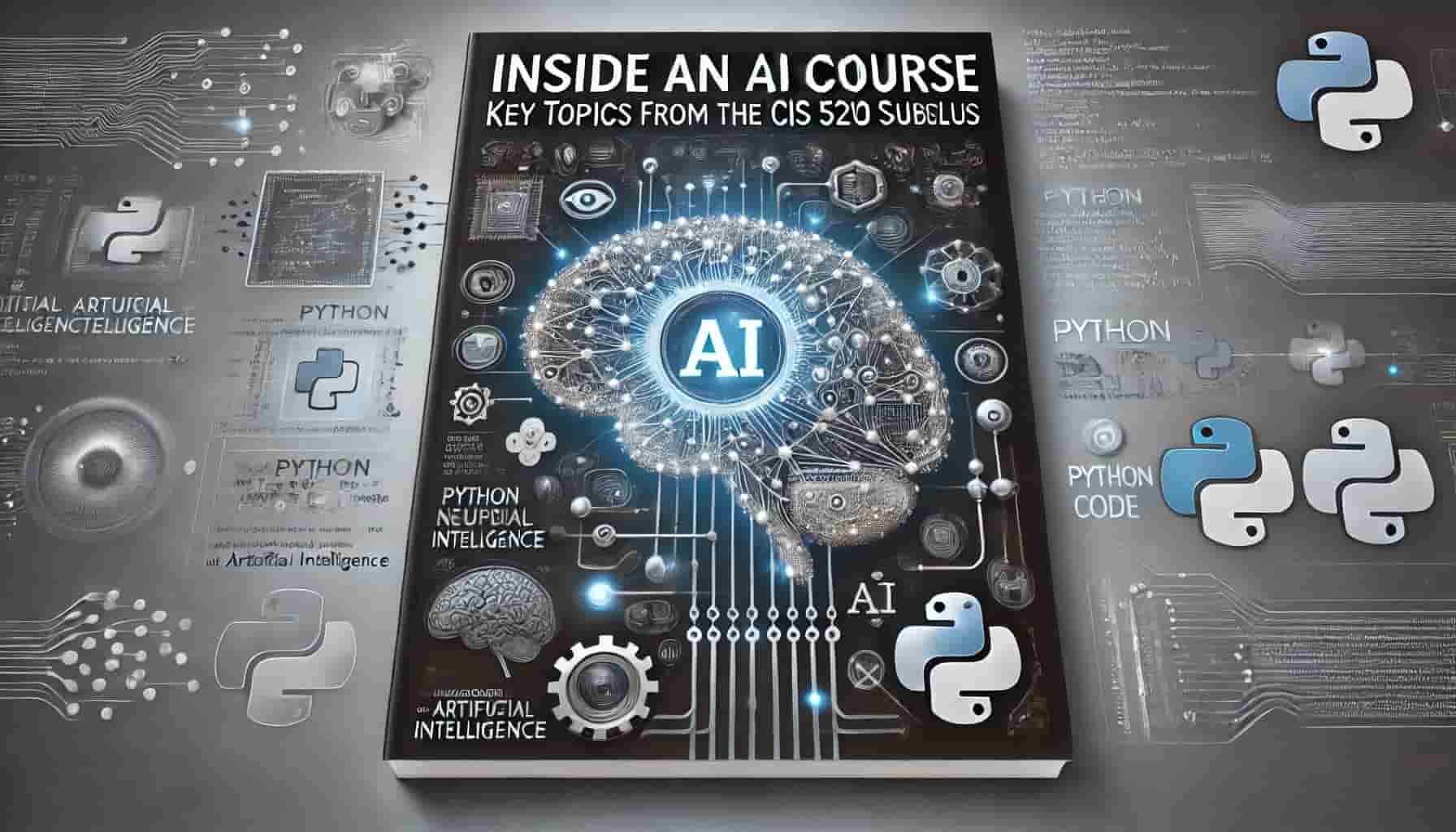Introduction
The Growing Significance of Artificial Intelligence (AI)
Artificial Intelligence (AI) is transforming the world as we know it. From personal assistants like Siri and Alexa to game-changing advancements in healthcare, finance, and autonomous vehicles, AI is no longer just a futuristic concept—it’s a vital part of our present and future. Companies and industries worldwide are racing to leverage AI for smarter decision-making, automation, and innovation, making AI education more critical than ever.
Overview of the CIS 5210 Course and Its Impact on AI Education
The CIS 5210 Artificial Intelligence syllabus from the University of Pennsylvania stands out as a comprehensive blueprint for understanding and mastering AI fundamentals. Designed for graduate-level students and professionals, the course covers everything from search algorithms and machine learning to natural language processing and probabilistic reasoning.
More than just theory, this course emphasizes practical application, equipping students with hands-on experience in programming intelligent systems using Python. By bridging the gap between academic rigor and real-world utility, CIS 5210 not only prepares students for the challenges of today’s AI landscape but also empowers them to become leaders in this dynamic field.
Table of Contents
- What Is the CIS 5210 Artificial Intelligence Syllabus?
- Core Topics in CIS 5210
- Hands-On Learning: Practical Assignments and Projects
- Additional Resources for Mastering the CIS 5210 Syllabus
- Conclusion
What Is the CIS 5210 Artificial Intelligence Syllabus?
The CIS 5210 Artificial Intelligence syllabus serves as a roadmap to understanding the core principles and cutting-edge techniques of AI. Offered by the University of Pennsylvania, this graduate-level course is meticulously structured to provide students with a strong foundation in AI while emphasizing real-world applications.1
Structure and Goals of the Syllabus
The syllabus is designed to achieve two primary goals:
- Establish a Theoretical Framework: Introduce students to the fundamental concepts of AI, including algorithms, logic, and probabilistic reasoning.
- Cultivate Practical Skills: Equip students with hands-on experience in programming and solving complex AI problems using Python.2
Students progress through carefully sequenced modules, each focusing on a specific aspect of AI. By the end of the course, they are expected to design and implement intelligent systems that can perceive, reason, and act in dynamic environments.
Foundational AI Concepts Covered
The course content revolves around key areas of AI, ensuring students build a comprehensive skill set:
- Search Algorithms:
Explore problem-solving methods such as uninformed search (e.g., Breadth-First Search, Depth-First Search) and informed search (e.g., A* algorithm), which are essential for navigating solution spaces efficiently. - Machine Learning:
Delve into supervised and unsupervised learning, reinforcement learning, and neural networks. These techniques enable machines to learn from data and make intelligent predictions. - Natural Language Processing (NLP):
Study how machines understand and process human language, enabling applications like chatbots, voice assistants, and sentiment analysis tools. - Probabilistic Reasoning:
Learn to manage uncertainty in decision-making using Bayesian networks and Markov models, which are vital in domains like robotics and diagnostics. - Knowledge Representation and Logic:
Discover how information can be encoded to enable machines to reason and draw inferences, simulating human-like problem-solving.
Balancing Theory and Practice
One of the most valuable aspects of the CIS 5210 syllabus is its balanced approach:
- Theoretical Rigor: Students gain a deep understanding of the algorithms and models that form the backbone of AI.
- Practical Application: Through coding assignments and projects, students apply theoretical knowledge to real-world challenges, such as optimizing search paths, designing predictive models, and creating natural language systems.
This blend of theory and practice ensures that students are not only prepared for academic success but also equipped to tackle real-world AI problems in industries ranging from tech to healthcare.
Core Topics in CIS 5210
The CIS 5210 syllabus introduces students to the foundational concepts of artificial intelligence, offering a comprehensive overview of the key principles driving the field. Through its focus on both theory and application, the artificial intelligence syllabus ensures students not only understand the basics but also gain the skills needed to solve complex problems in real-world scenarios. Below is a detailed breakdown of the major topics covered in this thoughtfully designed course.

Search Algorithms
Search algorithms form an essential component of the syllabus for CIS 5210, offering students tools to solve complex problems systematically. Key strategies include:
- Uninformed Search:
- Algorithms like Breadth-First Search (BFS) and Depth-First Search (DFS) focus on exhaustive exploration without prior knowledge.
- Applications: Puzzle-solving, pathfinding in games, and exploring state spaces.
- Informed Search:
- Techniques such as the A* algorithm use heuristics to optimize searches, making them more efficient.
- Applications: GPS route planning, AI for robotics, and network optimization.
Machine Learning
The course covers:
- Supervised Learning:
- Students explore models like Linear Regression and Neural Networks to predict outcomes from labeled data.
- Applications: Image recognition, spam filtering, and predictive modeling.
- Unsupervised Learning:
- Clustering algorithms like K-Means help students uncover patterns in unlabeled data.
- Applications: Market segmentation, anomaly detection, and recommendation systems.
- Reinforcement Learning:
- Techniques like Q-Learning enable agents to learn optimal actions by interacting with their environments.
- Applications: Game-playing agents (e.g., AlphaGo), robotics, and decision-making systems.
Probabilistic Reasoning
Key topics include:
- Bayesian Networks: Representing probabilistic relationships among variables.
- Markov Decision Processes (MDPs): Modeling decision-making where outcomes are partially random.
- Applications: Fraud detection, predictive maintenance, and medical diagnosis.
Natural Language Processing (NLP)
NLP is the bridge between human language and machines, Students explore:
- Language Modeling: Predicting word sequences for improved text understanding.
- Parsing and Syntax: Analyzing sentence structures to extract meaning.
- Applications: Chatbots, machine translation, and sentiment analysis.
Knowledge Representation and Logic
- Propositional and Predicate Logic: Techniques for reasoning about facts and relationships.
- Ontology Building: Organizing hierarchical knowledge for efficient inference.
- Applications: Expert systems, semantic web development, and automated planning.
Hands-On Learning: Practical Assignments and Projects
Python Programming as the Primary Tool
Python, the de facto language for AI and machine learning, serves as the backbone of the course’s practical components. Its simplicity, extensive libraries (like NumPy, TensorFlow, and scikit-learn), and robust community make Python ideal for implementing AI concepts. Students gain proficiency in using Python to:
- Build search algorithms for navigating large data spaces.
- Train machine learning models for predictive analytics.
- Develop natural language processing (NLP) applications, such as chatbots or sentiment analysis tools.
This focus on Python programming not only enhances students’ technical skill sets but also aligns with industry standards, ensuring they are job-ready upon graduation.
Examples of Practical Assignments
Assignments in CIS 5210 are carefully designed to reinforce theoretical knowledge through practical application. Here are a few examples:
- Search Algorithm Implementation:
- Task: Code algorithms like A* and Depth-First Search to solve pathfinding problems.
- Relevance: Search algorithms are widely used in robotics, logistics, and game development for navigation and optimization tasks.
- Machine Learning Model Development:
- Task: Train a supervised learning model (e.g., logistic regression or decision tree) on a dataset to make predictions, such as classifying emails as spam or non-spam.
- Relevance: These skills are essential in data science roles across various domains, from marketing to healthcare.
- Reinforcement Learning Simulation:
- Task: Implement Q-learning to train an agent to play a simplified game or optimize a process.
- Relevance: Reinforcement learning is critical in industries like autonomous vehicles and stock market trading.
- NLP Application Development:
- Task: Create a simple chatbot that can respond to user queries or perform sentiment analysis on text data.
- Relevance: NLP skills are increasingly in demand for developing AI-driven customer support solutions and voice-activated systems.
Additional Resources for Mastering the CIS 5210 Syllabus
The CIS 5210 Artificial Intelligence syllabus covers a diverse range of topics, making it essential for students to supplement their learning with external resources. Whether you’re enrolled in the course or exploring its topics independently, leveraging additional materials can deepen your understanding and help you master complex concepts.
Recommended Books
- Artificial Intelligence: A Modern Approach by Stuart Russell and Peter Norvig3
- Known as the gold standard for AI education, this book comprehensively covers topics like search algorithms, probabilistic reasoning, machine learning, and more.
- Why it’s helpful: The detailed explanations and real-world examples align closely with the CIS 5210 syllabus.
- Deep Learning4 by Ian Goodfellow, Yoshua Bengio, and Aaron Courville
This book provides an in-depth look at neural networks and deep learning, critical for understanding advanced machine learning concepts.
Why it’s helpful: Theoretical and practical insights make it an excellent companion for mastering machine learning topics in the syllabus. - Speech and Language Processing5 by Daniel Jurafsky and James H. Martin
Focused on NLP, this resource delves into syntax, semantics, and advanced language models.
Why it’s helpful: It complements the natural language processing segment of the course.
Online Courses and Tutorials
- Machine Learning by Andrew Ng (Coursera)
- A beginner-friendly introduction to machine learning, covering algorithms, supervised/unsupervised learning, and neural networks.
- Why it’s helpful: Perfect for reinforcing the foundational machine learning concepts in CIS 5210.
- CS50’s Introduction to Artificial Intelligence with Python (edX)
- This course combines AI theory with Python-based projects, covering search algorithms, machine learning, and more.
- Why it’s helpful: Its emphasis on Python mirrors the programming focus of CIS 5210.
- Fast.ai Deep Learning for Coders
- A hands-on deep learning course that makes complex topics accessible to programmers with basic machine learning knowledge.
- Why it’s helpful: Ideal for diving deeper into neural networks and practical implementations.
Study Tips for Understanding Complex Topics
- Break Down Topics into Manageable Parts
- For example, if you’re studying search algorithms, start with basic concepts like state spaces before moving on to A* and heuristic optimization.
- Experiment with Code
- Recreate algorithms and models from scratch using Python. Debugging your own implementations is one of the fastest ways to solidify your understanding.
- Leverage Visualizations
- Tools like TensorBoard (for machine learning) and graphing libraries like Matplotlib can help you visualize complex processes, such as search trees or neural network activations.
- Participate in AI Communities
- Join forums like Reddit’s r/MachineLearning6 or Kaggle’s community to discuss concepts, share projects, and learn from others.
- Work on Small Projects
- Build a chatbot, train a simple reinforcement learning agent, or solve a classic AI puzzle like the 8-puzzle game. Small projects help apply theoretical concepts in a hands-on way.
Conclusion
The CIS 5210 Artificial Intelligence syllabus offers an exceptional foundation for understanding and mastering the core principles of AI. By covering essential topics such as search algorithms, machine learning, probabilistic reasoning, natural language processing, and knowledge representation, the course equips students with both theoretical knowledge and hands-on skills. Its focus on Python programming and practical assignments ensures that graduates are not only academically prepared but also industry-ready, capable of addressing real-world AI challenges.
For AI aspirants, the value of a course like CIS 5210 extends beyond the classroom. It provides the tools and mindset needed to innovate, problem-solve, and excel in a rapidly evolving field. Whether you aim to build intelligent systems, conduct research, or develop applications that transform industries, this course is an excellent stepping stone.
But the journey doesn’t stop here. Artificial intelligence is a vast and dynamic domain, with new advancements emerging daily. To truly excel, continue exploring similar educational opportunities—whether through advanced university courses, online platforms, or independent projects. Dive deeper into AI concepts, experiment with the latest tools, and engage with the global AI community to stay at the forefront of this exciting field.
Artificial intelligence is shaping the future. With the right knowledge and skills, you can be part of the transformation.
